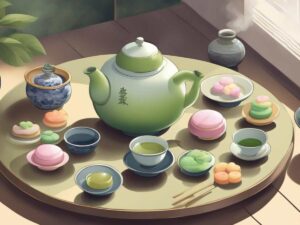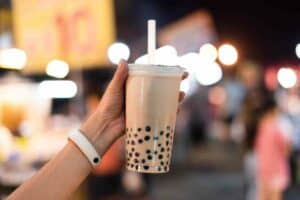Sashimi is a traditional Japanese way of dining.
It’s a practice that dates back thousands of years and involves eating raw fish that has been thinly sliced.
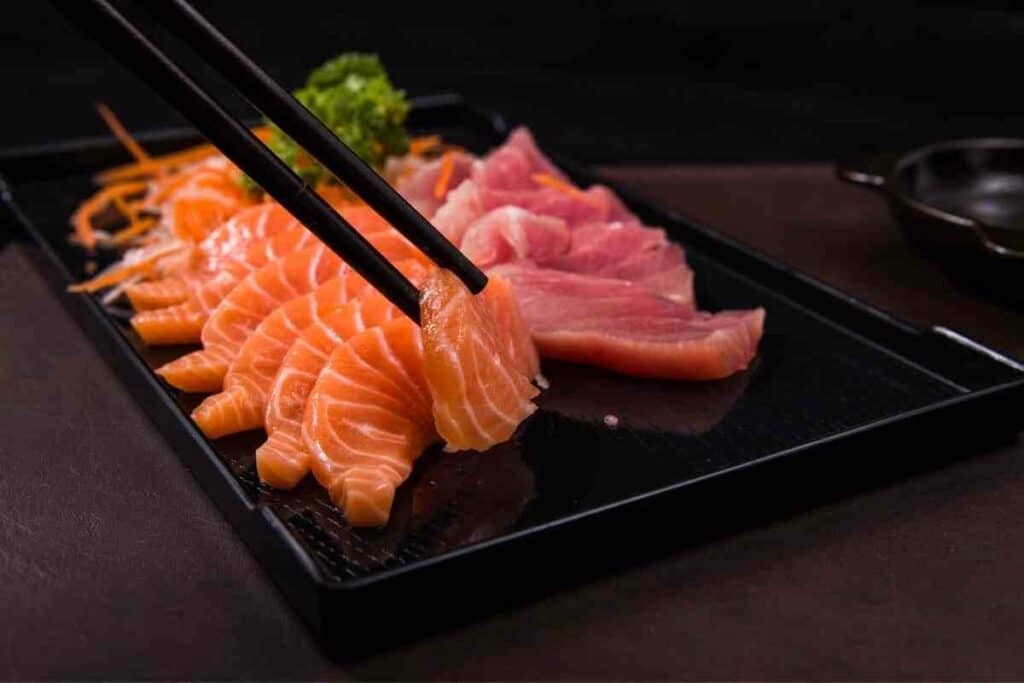
Though it’s now a Japanese tradition, it originally came from China circa 500 BC.
The term sashimi means ‘cut body’ in Japanese. However, in kanji they use the character that means ‘pierce’ because the character for ‘cut’ was reserved for samurai.
Sashimi can refer to any meat, including raw chicken, beef, and horse, the most common is fish and seafood.
To Make Sashimi – The ingredients are cut into bite-sized shapes like thin slices, small rectangles, or julienned slivers. This food is often eaten alone as a treat paired with sake or beer, or it forms a part of a larger meal.
Table of Contents
How is sashimi eaten?
You’ll typically be served sashimi on ice or on a platter with a garnish.
Garnishes typically range from shredded radish, perilla herbs, chrysanthemum flowers, red water pepper sprouts, or even the tail or head of the fish or the shell of the shellfish from which the sashimi was taken.
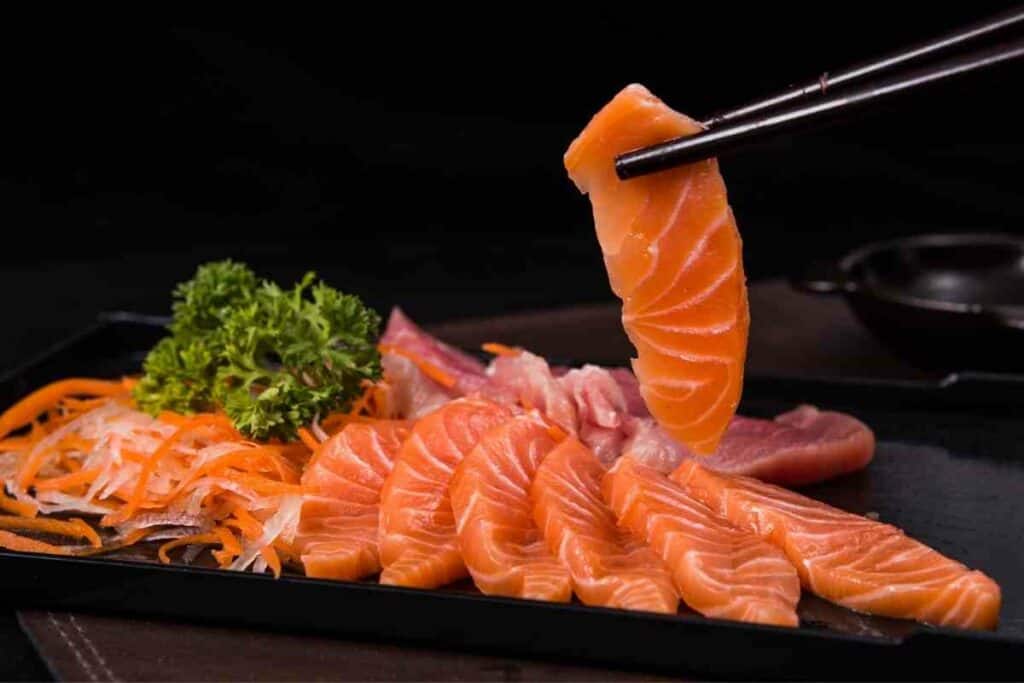
In terms of condiments, you’ll get soy sauce, wasabi, and ponzu. Sashimi is eaten with chopsticks.
The idea behind sashimi is that it’s a true taste experience so the ingredients are high quality, and you shouldn’t use too many condiments so that you experience the true flavor.
Let’s take a look at some different types of sashimi.
1. Sake
Sake is freshly cut raw salmon. This fish is amongst the most popular for making sashimi.
The meat from the salmon’s belly is more succulent and fatty and so this is preferred when making this dish.
Of course, you can expect to pay more for salmon belly.
People are advised to be careful when eating sake sashimi because raw salmon can contain parasites.
To Resolve This Concern – People should choose farmed salmon that will be free from parasites or wild salmon that has previously been frozen to kill parasites.
You can easily recognise this fish by its orange color.
2. Akami
This is a cut of tuna that is cheaper than other cuts.
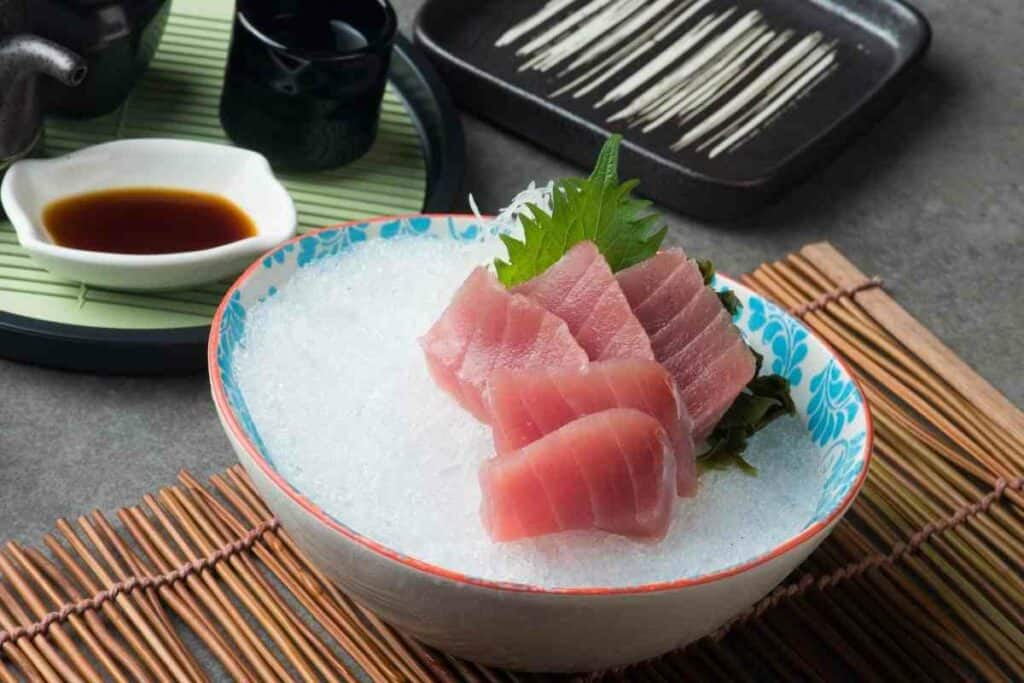
It is dark red in color and has a low-fat content, which is considered to be a bad thing.
In Japan, the fat in tuna is said to have great health properties because of its high DHA content.
It is the most commonly used tuna for sashimi in Japan. Texture-wise it is leaner and meatier, and it has a bolder taste.
Booking.com3. Katsuo
Katsuo (bonito) sashimi is unique.
It is a seasonal delicacy that is served at the start of summer.
The reason for its uniqueness is because it’s the only type of sashimi that is either seared before it’s eaten or is eaten with garlic.
It’s often served with wasabi, ginger, and green onions too.
When it’s served seared, it still remains raw on the inside. This is called katsuo no tataki.
4. Ahi
Ahi is either yellowfin or bigeye tuna.
Yellowfin has a milder flavor and is ideal for sashimi thanks to its firm texture.
Bigeye tuna has a buttery flavor and a higher amount of fat.
5. Engawa
Engawa is the Japanese name for halibut.
This makes a very good fish for making sashimi because you can cut it really thinly.
The part that is used for engawa sashimi is a cut of the halibut’s fin.
Though the texture can be a little tough, the fatty part has a high collagen content.
6. Hotate
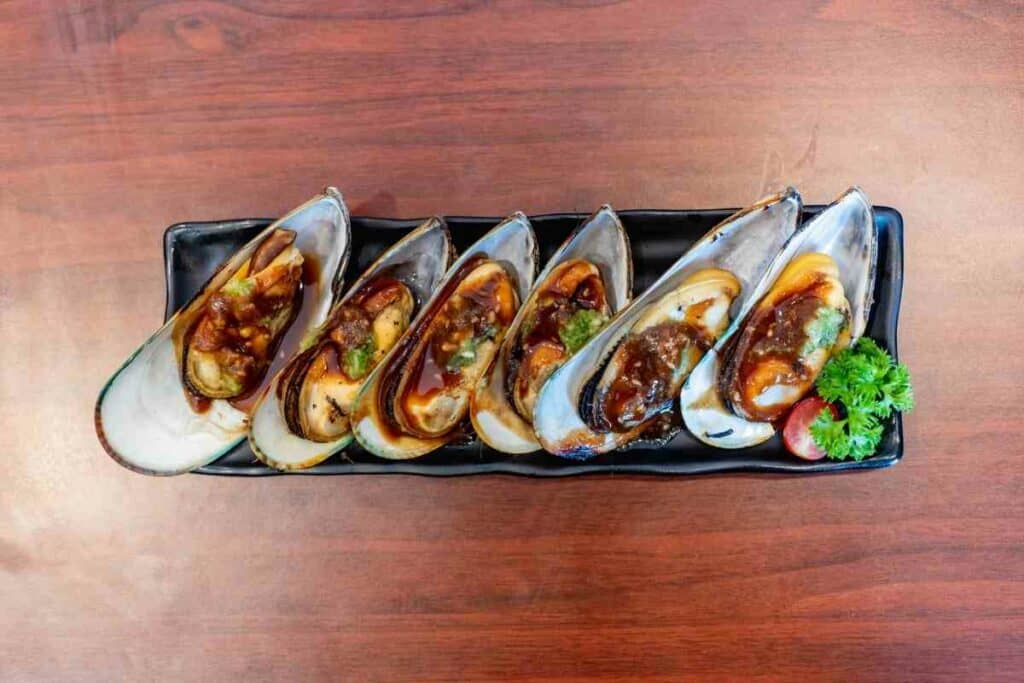
Hotate is scallops. These are very creamy and sweet when they are served straight out of their shells as sashimi.
They have a different texture and taste compared to those used for sushi.
7. Ebi
Another seafood sashimi is ebi.
This is made of prawns or sweet shrimp and there are several different varieties of shrimp used for sashimi.
This includes amaebi which are smaller and botan ebi, which are larger.
For a higher fat content, red shrimp, aka ebi, is higher in fat while Japanese tiger prawns, kuruma ebi, are a considered a delicacy.
8. Hokkigai, Akagai, Tsubugai, Mirugai
Hokkigai, akagai, tsubugai, and mirugai are all types of clams.
Hokkigai is surf clam, akagai are red clam, tsubugai are whelk, and mirugai are geoduck clam.
Hokkigai are popular for sashimi thanks to their sweet flavor and meaty texture. Akagai, on the other hand, have a subtle and mild taste.
Tsubugai has a sweet flavor with a cruncy texture.
Finally, mirugai have a subtle, sweet flavor, are a little cruncy, and have a briny aroma.
9. Ika
When it is cut in sections, ika (or squid) is flat and thin.
Ika is usually julienned so that it is attractive as thin slivers for sashimi.
This is a white meat that is almost translucent.
When you’re served a good quality ika sashimi it will be crisp and tender with a delicate sweet taste.
If it has an odd taste or is gum-like in consistency, it is likely not fresh.
10. Tako
Tako means octopus in Japanese.
When it’s eaten in other dishes, it’s usually boiled as it can be rubbery and chewy if it’s not prepared well.
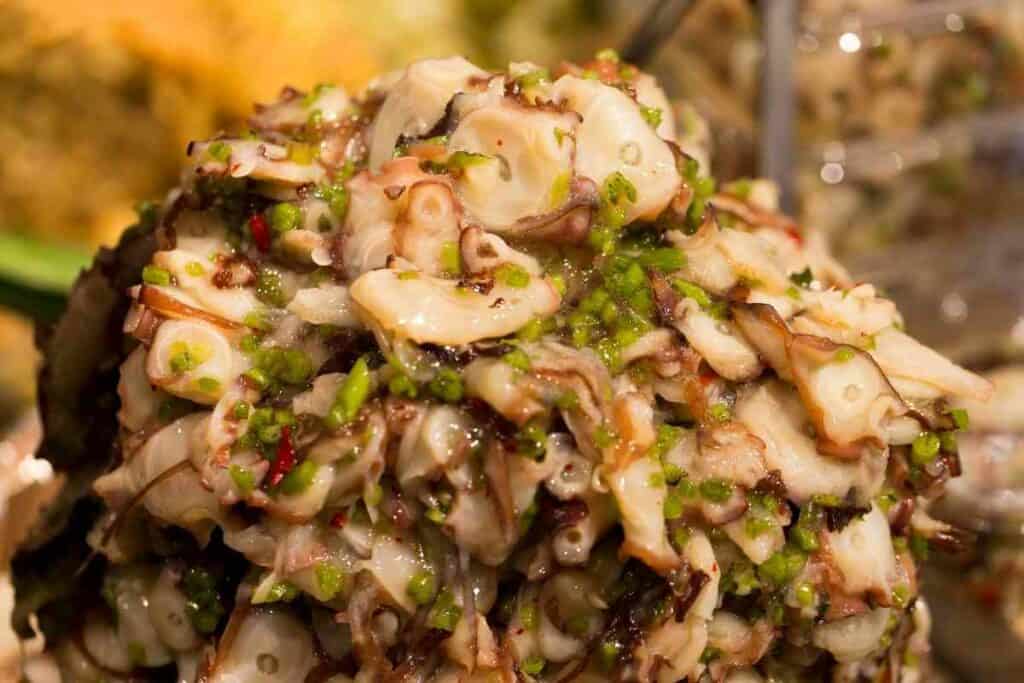
For sashimi, which is raw, it’s important to slice the tako thinly.
This helps it to be chewed more easily and also draws out a subtle, sweet aroma.
Tako is a strange fish to use for sashimi but when prepared in the correct way, it is delicious.
11. Saba
Mackerel is an oily fish with a strong flavor.
This makes it a real sashimi favorite – especially when it’s very fresh. Saba is often cured with salt and vinegar before it’s served.
When it’s not used as a sashimi ingredient, it is grilled.
As Sashimi – It is bold in flavor and goes well with grated ginger and green onions.
12. Aji
Aji is horse mackerel and is an inexpensive and popular fish found in abundance around China, Korea, and Japan.
It has a complex flavor with a slight fishiness and a firm texture.
It might be accompanied by green onions and ginger. When served as sashimi, the aji will have its skin removed and will likely be scored.
Even though it’s called horse mackerel, it’s not actually mackerel at all.
Rather, it’s a type of silver-skinned fish called hikarimono. It is related to kanpachi and hamachi.
13. Hamachi/kanpachi
Hamachi is yellowtail. It is a popular fish for making sashimi.
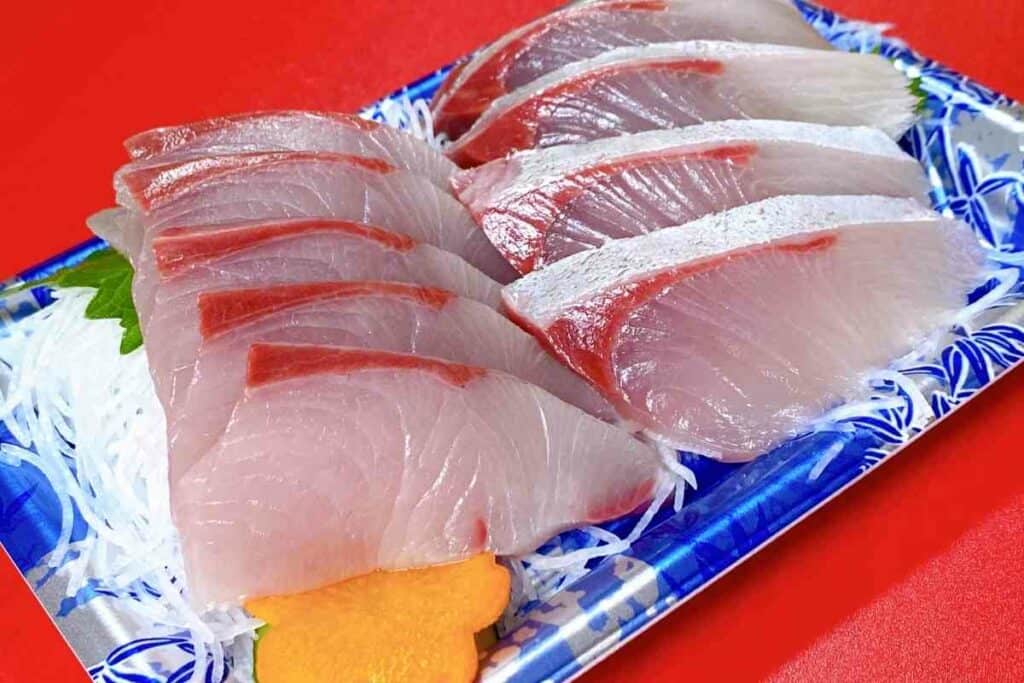
It has a buttery and rich flavor. Usually, the belly of the yellowtail is used for sashimi while the upper part of this fish is used for another dish called nigiri sushi.
This fish is seasonal and is around in the early summer months. It has a light pink-white color and is almost translucent.
14. Tai
Tai (sea bream/red snapper) is a popular fish for sashimi as it is savory with a slight sweetness.
It is either caught in the wild or farmed. Tai is often cured with layers of kelp in between as this helps to bring out stronger and more complex flavors.
Tai is a highly prized fish with a great texture, color, and flavor. Owing to this, it is considered to be a good luck symbol and a celebration.
15. Sanma
Sanma is another type of mackerel and red fish.
It’s usually served with green onion or myoga in thin slices, and grated ginger.
Sanma is usually served with wasabi and soy sauce, though not a lot so as not to impede the flavor.
16. Suzuki
Suzuki or sea bass is a delicious fish with white flesh and a mild taste.
The belly meat is soft and has more fat, while the back meat is firmer but has a delicious flavor.
17. Hirame
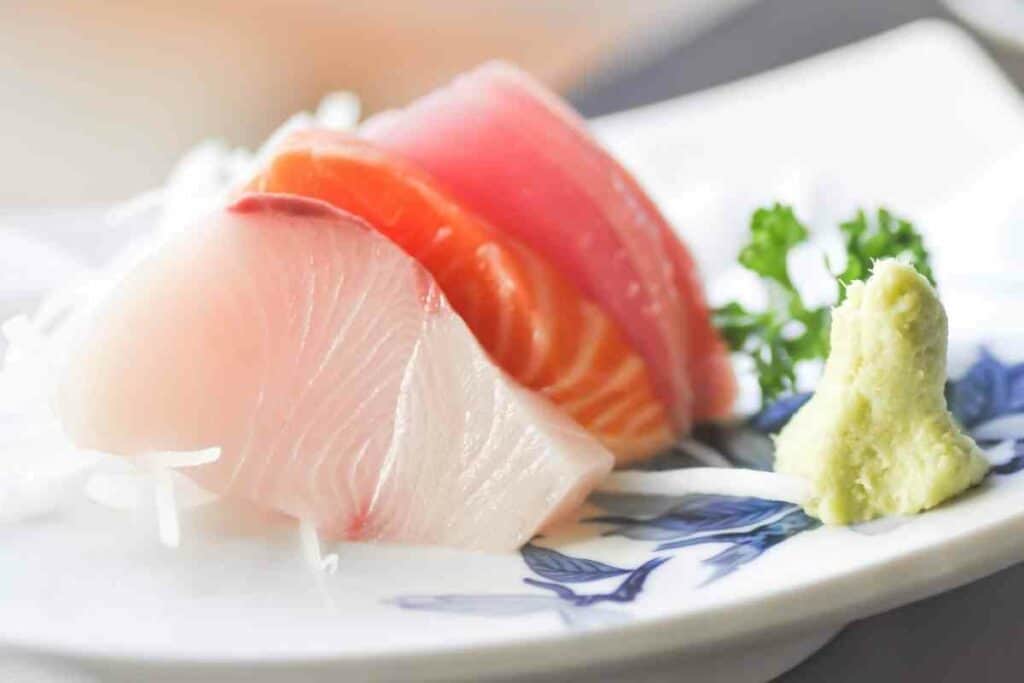
Hirame (flounder) is a firm, white or white and pink with a mild flavor.
Winter hirame is more desirable because the fat content in the fish is higher at this time of year.
With hirame, you can age the fish for a few days before serving. This maximizes its texture and flavor.
18. Ikura
Ikura is salmon roe. This food is popular in Japanese dishes.
It’s sometimes referred to as red caviar due to its salmon color. The roe has a briny flavor and soft texture.
It’s usually sourced from the end of summer through fall.
Though salmon roe is served in many different ways, it can be served alone as sashimi.
It’s usually laid on a shiso leaf or on top of a piece of cucumber, which makes it very healthy.
19. Uni
If you see uni sashimi on a menu, you’re looking at sea urchin.
With this sashimi, there is no need for chewing as uni is so soft.
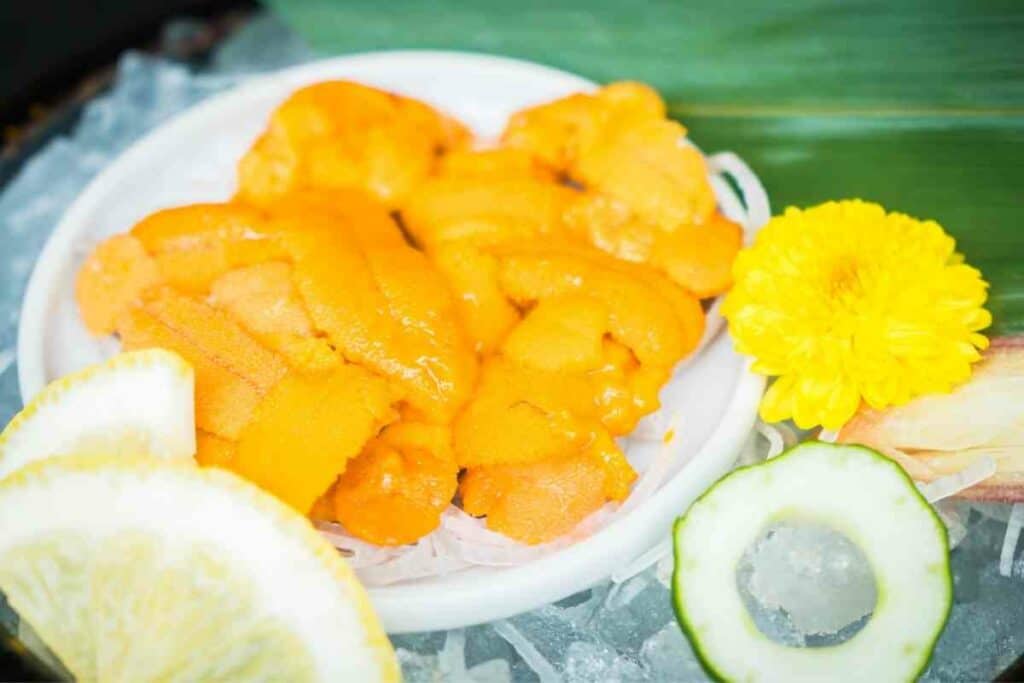
There is a common misconception that uni sashimi is made of the eggs or roe of the sea urchin, but it’s actually the gonads – i.e., the ovaries and testicles – that make up the dish!
Concluding thoughts on different types of sashimi
So, there you have it, nineteen different types of sashimi available in Japan.
And if you thought sashimi was similar to sushi, you’ll now understand how it is different.
While it’s probably unlikely that you’ll get to try them all in one sitting, it’s worth trying as many types as you can to get a true idea of what’s involved in this Japanese cuisine.
Read Next
- Japanese Traditional Sweets (Wagashi): A Guide to Their Origins and Varieties
- A Taste of Japan in Every Bite – Japanese Candy & Snack Box Review
- Bubble Tea vs Boba Compared: What’s the Difference?
- Best Izakaya Foods for a Relaxed Night Out (My Top 10 Picks)
- Edo Kiriko Whiskey Glasses (Japanese Heritage in Every Pour)
- Japanese Viral Foods on Social Media (Discover the Top 10)

